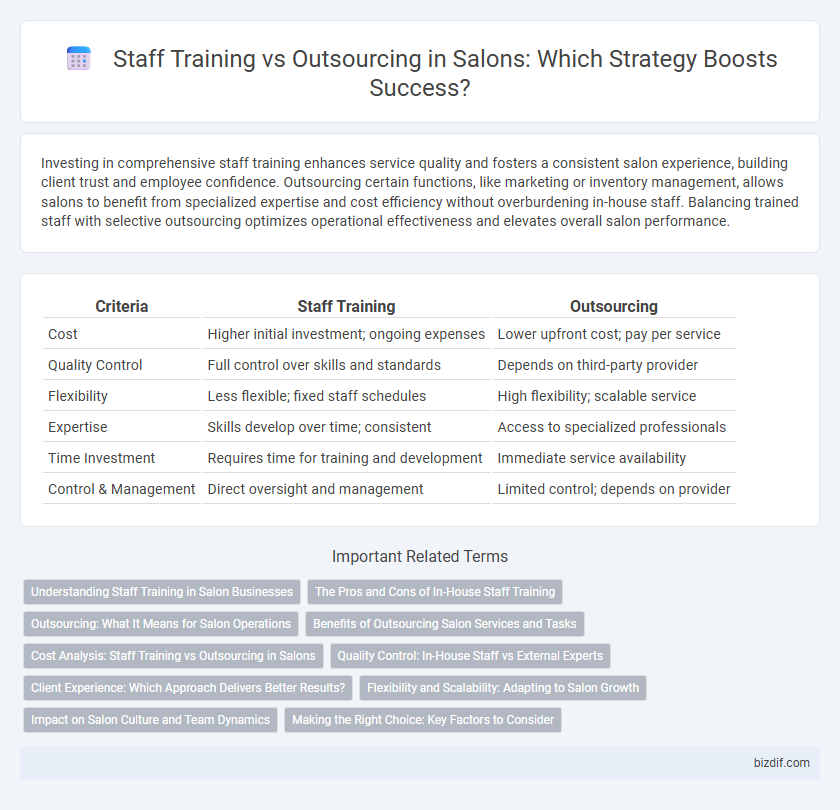Investing in comprehensive staff training enhances service quality and fosters a consistent salon experience, building client trust and employee confidence. Outsourcing certain functions, like marketing or inventory management, allows salons to benefit from specialized expertise and cost efficiency without overburdening in-house staff. Balancing trained staff with selective outsourcing optimizes operational effectiveness and elevates overall salon performance.
Table of Comparison
| Criteria | Staff Training | Outsourcing |
|---|---|---|
| Cost | Higher initial investment; ongoing expenses | Lower upfront cost; pay per service |
| Quality Control | Full control over skills and standards | Depends on third-party provider |
| Flexibility | Less flexible; fixed staff schedules | High flexibility; scalable service |
| Expertise | Skills develop over time; consistent | Access to specialized professionals |
| Time Investment | Requires time for training and development | Immediate service availability |
| Control & Management | Direct oversight and management | Limited control; depends on provider |
Understanding Staff Training in Salon Businesses
Staff training in salon businesses enhances service quality by equipping employees with up-to-date techniques, customer service skills, and product knowledge specific to haircare, skincare, and beauty treatments. Well-trained staff contribute to increased client satisfaction, repeat business, and a strong salon reputation, directly impacting revenue growth. Investing in ongoing education and professional development ensures that salons remain competitive in an ever-evolving beauty industry.
The Pros and Cons of In-House Staff Training
In-house staff training in salons ensures consistent service quality and fosters a strong team culture by directly aligning skill development with the business's brand standards. It requires significant time and financial investment, potentially diverting focus from core operations and leading to slower adaptation of new techniques. However, salons benefit from greater control over employee performance, customized training programs, and enhanced client satisfaction through well-trained, knowledgeable staff.
Outsourcing: What It Means for Salon Operations
Outsourcing salon services such as hair coloring, skincare, and nail treatments allows salons to access specialized expertise without investing in extensive staff training. This approach reduces operational costs and ensures consistent, high-quality service by leveraging external professionals with advanced skills. Moreover, outsourcing enables salons to offer a wider range of services, enhancing client satisfaction and boosting overall business growth.
Benefits of Outsourcing Salon Services and Tasks
Outsourcing salon services such as bookkeeping, marketing, and appointment scheduling enhances operational efficiency by allowing specialized professionals to handle critical tasks, leading to improved service quality and client satisfaction. This approach reduces overhead costs associated with recruiting, training, and retaining in-house staff, enabling salons to allocate resources more strategically. Leveraging external expertise ensures access to the latest industry tools and trends, fostering scalability and increased competitiveness in the beauty market.
Cost Analysis: Staff Training vs Outsourcing in Salons
Analyzing cost differences between staff training and outsourcing in salons reveals that investing in staff training involves upfront expenses for courses and ongoing development but can lead to long-term savings and improved service consistency. Outsourcing may reduce immediate labor costs and administrative burdens but can result in higher hourly rates and less control over service quality. Salons must weigh the balance between initial training investment and potential variable costs of outsourcing to optimize financial efficiency.
Quality Control: In-House Staff vs External Experts
Maintaining high-quality service in salons hinges on effective staff training versus outsourcing specialized tasks to external experts. In-house staff training ensures consistent adherence to brand standards and allows for personalized skill development, resulting in reliable client experiences. Outsourcing to external professionals can bring advanced expertise but may introduce variability in service quality and less direct control over client interactions.
Client Experience: Which Approach Delivers Better Results?
Investing in staff training enhances client experience by equipping salon employees with personalized skills and deep product knowledge, fostering trust and repeat visits. Outsourcing certain services can introduce expert techniques and efficiency but may lack the consistency and personalized touch that in-house trained staff provide. Salons prioritizing tailored client engagement and long-term relationships often see better results through comprehensive staff development programs.
Flexibility and Scalability: Adapting to Salon Growth
Staff training enhances flexibility by equipping in-house employees with versatile skills tailored to evolving salon services, ensuring consistent quality and brand alignment. Outsourcing offers scalability by allowing salons to quickly adjust workforce size based on demand fluctuations without long-term employment commitments. Combining both approaches provides optimal adaptability, supporting seamless expansion and diverse service offerings in a competitive market.
Impact on Salon Culture and Team Dynamics
Investing in staff training strengthens salon culture by fostering a cohesive team that shares core values and skills, leading to consistent service quality and improved client satisfaction. Outsourcing, while cost-effective, can disrupt team dynamics as external professionals may not fully integrate into the salon's atmosphere or align with its brand identity. Maintaining in-house expertise cultivates loyalty and collaboration, crucial for a thriving salon environment.
Making the Right Choice: Key Factors to Consider
Choosing between staff training and outsourcing in a salon hinges on factors like cost efficiency, service quality, and scalability. Investing in comprehensive staff training enhances skill consistency and client retention, while outsourcing offers flexibility and access to specialized expertise without long-term commitments. Evaluating client expectations, operational budget, and the salon's growth strategy helps determine the ideal balance for optimal performance and profitability.
Staff Training vs Outsourcing Infographic

 bizdif.com
bizdif.com